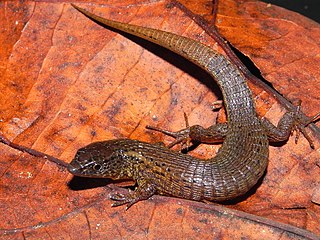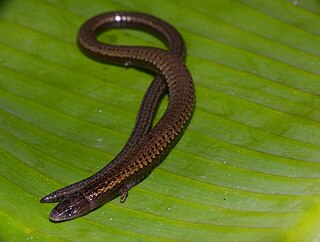
Enyalioides is a genus of lizards in the family Hoplocercidae. The genus is native to the northern part of South America and Panama.

Alopoglossus is a genus of lizards in the monogeneric family Alopoglossidae. The genus is distributed from Costa Rica in Central America to northern South America.

Bachia is a genus of lizards that belong to the spectacled lizards family.

Cercosaura is a genus of lizards in the family Gymnophthalmidae. The genus is endemic to South America.

Pholidobolus is a genus of lizards in the family Gymnophthalmidae. They occur in north-western South America.
The Key tegu is a species of lizard in the family Gymnophthalmidae. The species is endemic to Ecuador.

Stenocercus is a genus of South American lizards, commonly called whorltail iguanas, of the family Tropiduridae. This genus has 80 valid described species.

Potamites is a genus of lizards in the family Gymnophthalmidae. The genus is restricted to northern South America and southern Central America. They are semiaquatic and found near streams.
Gelanesaurus is a genus of lizards in the family Gymnophthalmidae. The genus contains two species, which are native to Colombia and Ecuador. Both species were included in the genus Potamites until 2016 when they were moved to the genus Gelanesaurus.
Gelanesaurus flavogularis is a species of lizard in the family Gymnophthalmidae. The species is endemic to Ecuador.
Petracola is a genus of lizards in the family Gymnophthalmidae. The genus is endemic to Peru.

Riama is a genus of lizards in the family Gymnophthalmidae. The genus is endemic to South America.
Andinosaura is a genus of lizards in the family Gymnophthalmidae. The genus is endemic to South America.
Selvasaura is a genus of the lizard family Gymnophthalmidae. The genus contains three species.
Cercosaura bassleri, known commonly as the ocellated tegu, is a species of lizard in the family Gymnophthalmidae. The species is endemic to Peru.

Cercosaura oshaughnessyi, known commonly as the white-striped eyed lizard, is a species of lizard in the family Gymnophthalmidae. The species is endemic to northern South America.
Gelanesaurus cochranae, also known commonly as Cochran's neusticurus, is a species of lizard in the family Gymnophthalmidae. The species is native to northwestern South America.
Macropholidus ataktolepis is a species of lizard in the family Gymnophthalmidae. It is endemic to Peru.
Macropholidus ruthveni, known commonly as Ruthven's macropholidus, is a species of lizard in the family Gymnophthalmidae. The species is endemic to northwestern South America.
Proctoporus rahmi, Rahm's sun tegu, is a species of lizard in the family Gymnophthalmidae. It is endemic to Peru.







